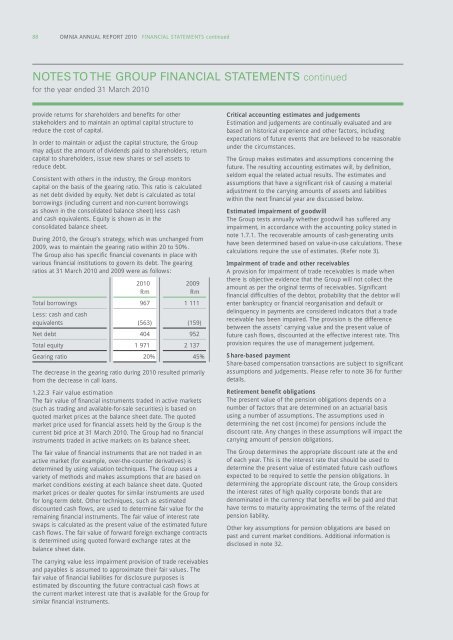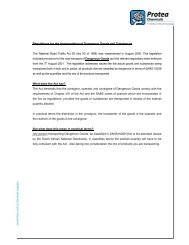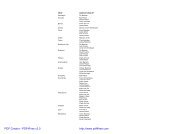omnia holdings annual report 2010 omnia holdings annu
omnia holdings annual report 2010 omnia holdings annu
omnia holdings annual report 2010 omnia holdings annu
Create successful ePaper yourself
Turn your PDF publications into a flip-book with our unique Google optimized e-Paper software.
88 OMNIA ANNUAL REPORT <strong>2010</strong> FINANCIAL STATEMENTS continued<br />
NOTES TO THE GROUP FINANCIAL STATEMENTS continued<br />
for the year ended 31 March <strong>2010</strong><br />
provide returns for shareholders and benefits for other<br />
stakeholders and to maintain an optimal capital structure to<br />
reduce the cost of capital.<br />
In order to maintain or adjust the capital structure, the Group<br />
may adjust the amount of dividends paid to shareholders, return<br />
capital to shareholders, issue new shares or sell assets to<br />
reduce debt.<br />
Consistent with others in the industry, the Group monitors<br />
capital on the basis of the gearing ratio. This ratio is calculated<br />
as net debt divided by equity. Net debt is calculated as total<br />
borrowings (including current and non-current borrowings<br />
as shown in the consolidated balance sheet) less cash<br />
and cash equivalents. Equity is shown as in the<br />
consolidated balance sheet.<br />
During <strong>2010</strong>, the Group’s strategy, which was unchanged from<br />
2009, was to maintain the gearing ratio within 20 to 50%.<br />
The Group also has specific financial covenants in place with<br />
various financial institutions to govern its debt. The gearing<br />
ratios at 31 March <strong>2010</strong> and 2009 were as follows:<br />
<strong>2010</strong><br />
Rm<br />
2009<br />
Rm<br />
Total borrowings 967 1 111<br />
Less: cash and cash<br />
equivalents (563) (159)<br />
Net debt 404 952<br />
Total equity 1 971 2 137<br />
Gearing ratio 20% 45%<br />
The decrease in the gearing ratio during <strong>2010</strong> resulted primarily<br />
from the decrease in call loans.<br />
1.22.3 Fair value estimation<br />
The fair value of financial instruments traded in active markets<br />
(such as trading and available-for-sale securities) is based on<br />
quoted market prices at the balance sheet date. The quoted<br />
market price used for financial assets held by the Group is the<br />
current bid price at 31 March <strong>2010</strong>. The Group had no financial<br />
instruments traded in active markets on its balance sheet.<br />
The fair value of financial instruments that are not traded in an<br />
active market (for example, over-the-counter derivatives) is<br />
determined by using valuation techniques. The Group uses a<br />
variety of methods and makes assumptions that are based on<br />
market conditions existing at each balance sheet date. Quoted<br />
market prices or dealer quotes for similar instruments are used<br />
for long-term debt. Other techniques, such as estimated<br />
discounted cash flows, are used to determine fair value for the<br />
remaining financial instruments. The fair value of interest rate<br />
swaps is calculated as the present value of the estimated future<br />
cash flows. The fair value of forward foreign exchange contracts<br />
is determined using quoted forward exchange rates at the<br />
balance sheet date.<br />
The carrying value less impairment provision of trade receivables<br />
and payables is assumed to approximate their fair values. The<br />
fair value of financial liabilities for disclosure purposes is<br />
estimated by discounting the future contractual cash flows at<br />
the current market interest rate that is available for the Group for<br />
similar financial instruments.<br />
Critical accounting estimates and judgements<br />
Estimation and judgements are continually evaluated and are<br />
based on historical experience and other factors, including<br />
expectations of future events that are believed to be reasonable<br />
under the circumstances.<br />
The Group makes estimates and assumptions concerning the<br />
future. The resulting accounting estimates will, by definition,<br />
seldom equal the related actual results. The estimates and<br />
assumptions that have a significant risk of causing a material<br />
adjustment to the carrying amounts of assets and liabilities<br />
within the next financial year are discussed below.<br />
Estimated impairment of goodwill<br />
The Group tests <strong><strong>annu</strong>al</strong>ly whether goodwill has suffered any<br />
impairment, in accordance with the accounting policy stated in<br />
note 1.7.1. The recoverable amounts of cash-generating units<br />
have been determined based on value-in-use calculations. These<br />
calculations require the use of estimates. (Refer note 3).<br />
Impairment of trade and other receivables<br />
A provision for impairment of trade receivables is made when<br />
there is objective evidence that the Group will not collect the<br />
amount as per the original terms of receivables. Significant<br />
financial difficulties of the debtor, probability that the debtor will<br />
enter bankruptcy or financial reorganisation and default or<br />
delinquency in payments are considered indicators that a trade<br />
receivable has been impaired. The provision is the difference<br />
between the assets’ carrying value and the present value of<br />
future cash flows, discounted at the effective interest rate. This<br />
provision requires the use of management judgement.<br />
Share-based payment<br />
Share-based compensation transactions are subject to significant<br />
assumptions and judgements. Please refer to note 36 for further<br />
details.<br />
Retirement benefit obligations<br />
The present value of the pension obligations depends on a<br />
number of factors that are determined on an actuarial basis<br />
using a number of assumptions. The assumptions used in<br />
determining the net cost (income) for pensions include the<br />
discount rate. Any changes in these assumptions will impact the<br />
carrying amount of pension obligations.<br />
The Group determines the appropriate discount rate at the end<br />
of each year. This is the interest rate that should be used to<br />
determine the present value of estimated future cash outflows<br />
expected to be required to settle the pension obligations. In<br />
determining the appropriate discount rate, the Group considers<br />
the interest rates of high quality corporate bonds that are<br />
denominated in the currency that benefits will be paid and that<br />
have terms to maturity approximating the terms of the related<br />
pension liability.<br />
Other key assumptions for pension obligations are based on<br />
past and current market conditions. Additional information is<br />
disclosed in note 32.














